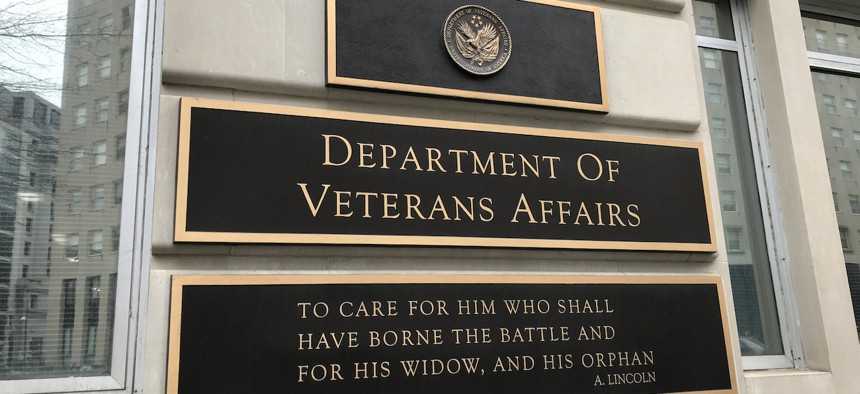
Veterans are getting the benefit of a laser focus on customer experience. Kiyoshi Tanno/Getty Images
VA is leading the way to restoring trust in government
COMMENTARY | The hard work of improving customer experience can restore faith and trust in government institutions.
If you saw the report on “60 Minutes” highlighting the Social Security Administration’s effort to claw back improper disability payments made based on its own errors, you probably seethed. SSA calculated benefits improperly, overpaid thousands of disabled people, and is now demanding they pay it back.
As practitioners dedicated to restoring trust in government, we think this goes in exactly the wrong direction. Making the neediest of our citizens repay based on the government’s mistake doesn’t just erode trust, it demolishes it. And SSA’s decision to cancel the claw back order for these three cases – after they were featured on “60 Minutes” -- makes it even worse.
Among the pillars in the Organization for Economic Cooperation and Development’s framework for assessing drivers of trust in government institutions is one directly related to customer experience. The relevant pillar in the OECD framework judges the extent to which government institutions “[p]rovide efficient, quality, affordable, timely and citizen-centered public services that are coordinated across levels of government and satisfy users.” SSA fails this test in this instance, but what about other areas of government?
It turns out, veterans are getting the benefit of a laser focus on customer experience. We recently spoke with Barbara Morton, deputy chief veterans experience officer for the Veterans Affairs Department. She won the Partnership for Public Service’s 2022 Samuel J. Heyman Service to America Award for Management for her work transforming the veteran experience.
Not so long ago, VA was, itself, the source of negative news stories about the quality and timeliness of care it provided veterans. Congress enacted the Veterans Access, Choice, and Accountability Act to improve the quality of service VA provided veterans and their families. It was around that time Morton began her work marshaling the resources of the government and her expertise in customer experience to fix what was broken.
As Morton demonstrates, VA has been on a sustained journey to transform the veteran experience by integrating human-centered design, leveraging data, and focusing on robust measures of customer experience. Human-centered design is the cornerstone of the department’s strategy: designing services and solutions with the veteran as the focal point. By asking Veterans about their needs, challenges, and experiences, VA creates more effective and accessible services. This method includes direct veteran involvement throughout the process.
Collecting and using customer experience data is also crucial. By collecting and analyzing extensive customer experience data, VA gains insights into the effectiveness of its services and identifies areas in need of improvement. The department and its practitioners get a comprehensive view of veterans' experiences, preferences, and pain points, enabling the VA to tailor its services to meet their specific needs. It enables overall agile performance and management practices in the agency.
The VA's approach to measuring customer experience is encapsulated in what it calls the three E's: ease, effectiveness, and emotion:
- Ease: how simple it is for veterans to access and navigate the VA's services. The goal is to streamline interactions, making them as effortless as possible.
- Effectiveness: how well are VA's services meeting the needs of Veterans. This includes the outcomes of service delivery, such as the timeliness and accuracy of benefits processing, the quality of healthcare services, and the impact of support programs.
- Emotion: Though subjective, this metric is equally important. It gauges Veterans' emotional responses to their interactions with the VA and whether they feel sufficiently honored and valued.
The department's quarterly report on the veterans experience provides a comprehensive analysis of these metrics, showcasing progress, identifying challenges, and setting future priorities. The report is not only a testament to the VA's commitment to continuous improvement but also a transparent communication tool that keeps Veterans informed about the efforts made on their behalf.
And what does it show? Veteran’s trust in VA increased from 55% in 2015 to almost 80% today. Because of significant, sustained commitment by Morton and the dedicated professionals at VA, this deserving community is regaining its confidence in the institution it turns to for care.
OECD’s framework suggests the hard work of improving customer experience can restore faith and trust in government institutions. VA has shown this to be the case. By continuously refining its approach based on direct feedback and measurable outcomes, the VA is setting a standard for government agencies aiming to put their clients' needs and experiences at the heart of their mission.
Beyond VA, the Biden administration is making significant strides transforming Americans’ experience with multiple government agencies when they are impacted by significant life events: retirement, financial shock, recovering from a disaster, having a child, and transitioning to civilian life. According to the OECD, getting these right is an important ingredient in restoring trust in government. The latest American Customer Satisfaction Index scores for government show measurable improvement. With trust in government at an all time low, we should all hope the administration’s efforts succeed.
G. Edward DeSeve is the coordinator of the Agile Government Center at the National Academy of Public Administration and executive fellow at the IBM Center for the Business of Government. Srikant Sastry is managing partner of advisory services at Cherry Bekaert.






